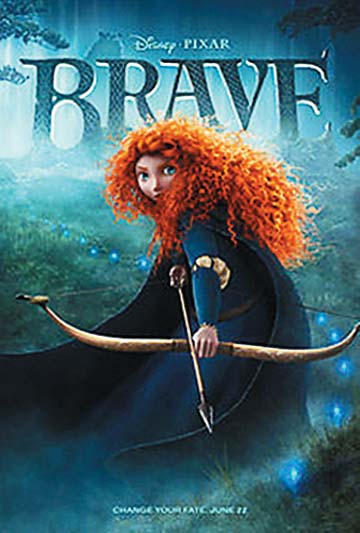|

If the Walt Disney Studios logo were the only one on “Brave,” this film’s wonderful visuals and brave heroine* would be enough to call it a success. But “Brave” is also a Pixar Animation Studios film, and that means it has to answer to a higher standard.
Pixar’s dozen previous features, including classics like “Toy Story,” “Up,” “Wall-E,” “Ratatouille” and “The Incredibles,” have used persuasive* wit* and singular characters to set a standard for computer-animated features that is the envy of the civilized world, or at least the rest of the movie business.
And though “Brave” has much to recommend it, its theme and characterization are too standard and its tone too broad to fit with the Pixar pedigree. Shown on its own, without any logo attached, “Brave” simply doesn’t feel as much like the Pixar movies we have come to expect.
Given that “Brave” does break new ground by being the first Pixar film to feature a heroine, that feeling of over-familiarity comes as a surprise.
It’s also a surprise because “Brave” starts out promisingly. Set in 10th century Scotland, its computer-generated look is so gorgeous and seems so authentic that you can practically feel the mist forming on your 3D glasses.
Merida is a skilled archer* and impetuous* daughter of King Fergus and Queen Elinor. Determined to carve her own path in life, Merida defies an age-old custom sacred to the lords of the land: Lord MacGuffin, Lord Macintosh and Lord Dingwall.
Merida’s actions carelessly lead to chaos* and fury* in the kingdom. When she turns to an eccentric* witch for help, she is granted an ill-fated* wish. The ensuing danger forces Merida to use all of her skills and resources — including her clever and naughty triplet* brothers — to undo a beastly curse before it’s too late, discovering the meaning of true bravery.
This being a Disney film, you can count on the ship being righted before the close. But it’s quite a slog to get there, especially since a chunk of that time is taken up with uninteresting male quarrels and buffoonery*.
It’s hard not to be affected by the emotional ending of “Brave,” but the magic, which is Pixar’s birthright — a sense of unending enchantment that is visible in the marvelous* short “La Luna” that plays before the feature, is absent more often than not. (SD-Agencies)
|

